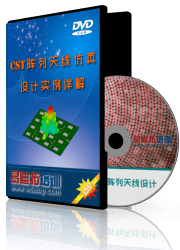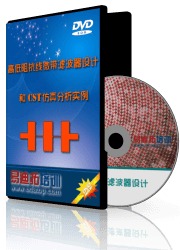- 易迪拓培训,专注于微波、射频、天线设计工程师的培养
CST2013: Boundary Conditions - Symmetry Planes
 Simulation: Settings
Simulation: Settings  Boundaries
Boundaries  Symmetry Planes
Symmetry Planes
If your model is symmetric, you may define this symmetry planes here.Important:
|
|
You can double-click on the symmetry plane frame in the main plot window to select one plane. By pressing the right mouse button in the main plot window, you can set the type of the symmetry for the selected plane using the popup menu.If you specify a symmetry plane, the calculation domain is cut in half. The picture on the right shows a calculation domain symmetric to the YZ plane. The symmetry type is electric. |
|
The calculation domain is cut in half twice more if a symmetry type for the XZ and XY can be found. |
|
Symmetry planes : YZ plane / XZ plane / XY plane
Specify whether you have a symmetry plane or not and in case you have one its type.
The type can be either an electric boundary or a magnetic boundary.
Thermal symmetry planes : YZ plane / XZ plane / XY plane
If an electromagnetic symmetry plane was defined it is possible to assign thermal properties to this symmetry in addition. For further information see the thermal symmetry page.
OK
Performs your settings and leaves the dialog box.
Cancel
Closes this dialog box without performing any further action.
Help
Shows this help text.
Boundary Conditions: Boundaries, Phase Shift/Scan Angle, Unit Cell, Boundary Temperature, Thermal Symmetry
CST微波工作室培训课程套装,专家讲解,视频教学,帮助您快速学习掌握CST设计应用
上一篇:CST2013: Asymptotic Solver Parameters
下一篇:CST2013: Asymptotic Solver Angle Sweep
CST涓枃瑙嗛鍩硅鏁欑▼ | More...
 最全面、最专业的CST微波工作室视频培训课程,可以帮助您从零开始,全面系统学习CST的设计应用【More..】
最全面、最专业的CST微波工作室视频培训课程,可以帮助您从零开始,全面系统学习CST的设计应用【More..】
频道总排行
- CST2013: Mesh Problem Handling
- CST2013: Field Source Overview
- CST2013: Discrete Port Overview
- CST2013: Sources and Boundary C
- CST2013: Multipin Port Overview
- CST2013: Farfield Overview
- CST2013: Waveguide Port
- CST2013: Frequency Domain Solver
- CST2013: Import ODB++ Files
- CST2013: Settings for Floquet B










